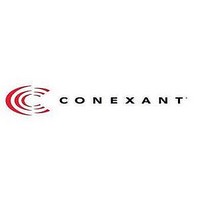bt8375kpf Conexant Systems, Inc., bt8375kpf Datasheet - Page 43

bt8375kpf
Manufacturer Part Number
bt8375kpf
Description
Single Chip Transceivers For T1/e1 And Integrated Service Digital Network Isdn Primary Rate Interfaces Systems
Manufacturer
Conexant Systems, Inc.
Datasheet
1.BT8375KPF.pdf
(323 pages)
Available stocks
Company
Part Number
Manufacturer
Quantity
Price
- Current page: 43 of 323
- Download datasheet (3Mb)
Bt8370/8375/8376
Fully Integrated T1/E1 Framer and Line Interface
2.4.1 ZCS Decoder
2.4.2 In-Band Loopback Code Detection
N8370DSE
The Receive Zero Code Suppression (RZCS) decoder decodes the dual rail data
(bipolar) into single rail data (unipolar). The Receive AMI bit (RAMI) in the
Receiver Configuration register [RCR0; addr 040] controls whether the received
signal is B8ZS/HDB3 decoded, depending on T1/E1N [addr 001] line rate
selection, or depending on whether the RZCS decoder is bypassed. If the line
code is unknown, the ZCSUB bit in Receive LIU Status [RSTAT; addr 021]
indicates that 1 or more B8ZS/HDB3 substitution patterns have been received on
the RTIP/RRING input. If the line code is B8ZS/HDB3 encoded, the RZCS bit in
RCR0 must be set to keep the LCV counter from counting BPVs that are part of
the B8ZS/HDB3 code.
The in-band loopback code detector circuitry detects receive data with in-band
codes of configurable value and length. These codes can be used to request
loopback of terminal equipment signals or other user-specified applications. The
two codes are referred to as loopback-activate and loopback-deactivate, although
the detectors need not be used only for loopback codes. Generally, any repeating
1–7 bit pattern can be selected. The loopback application is described in Section
9.3.1 of ANSI T1.403-1995. The loopback activate code is set in the Loopback
Activate Code Pattern [LBA; addr 043]. The loopback deactivate code is set in the
Loopback Deactivate Code Pattern [LBD; addr 044].
programmed for 4, 5, 6, or 7 bits by setting the code length bits of the Receive
Loopback Code Detector Configuration register [RLB; addr 042]. Shorter codes
can be programmed by repeating the expected pattern (e.g., 3+3 bit code
programmed as 6-bit code).
in Alarm 2 register [ALM2; addr 048], and the corresponding LOOPUP or
LOOPDN bit in Alarm 2 Interrupt Status register (ISR6; addr 005] is set. The
loopback detection interrupt can be enabled using the Alarm 2 Interrupt Enable
register [IER6; addr 00D]. When enabled, a loop-up or loop-down code detection
causes the Alarm 2 Interrupt bit [ALARM2] to be set in the Interrupt Request
register [IRR; addr 003] and generates an interrupt. Since loopbacks are not
automatically initiated, the processor must intercept and interpret the interrupt
status condition to determine when it must enable or disable the loopback control
mechanism (e.g., LLOOP; addr 014).
The sequence length for the loopback activate and deactivate codes can be
When a loopback code is detected, the LOOPUP or LOOPDN status bit is set
The in-band loopback code detector circuitry is only applicable to T1 mode.
T1 In-Band Loopback Codes
Activate 00001
Deactivate 001
Conexant
2.0 Circuit Description
2.4 Receiver
2-15
Related parts for bt8375kpf
Image
Part Number
Description
Manufacturer
Datasheet
Request
R

Part Number:
Description:
Bluetooth RF Transceiver
Manufacturer:
Conexant Systems, Inc.
Datasheet:

Part Number:
Description:
Bluetooth RF Transceiver
Manufacturer:
Conexant Systems, Inc.
Datasheet:

Part Number:
Description:
ATM transmitter/receiver with UTOPIA interface
Manufacturer:
Conexant Systems, Inc.
Datasheet:

Part Number:
Description:
Service SAR controller
Manufacturer:
Conexant Systems, Inc.
Datasheet:

Part Number:
Description:
CN8223EPFATM Transmitter/Receiver with UTOPIA Interface
Manufacturer:
Conexant Systems, Inc.
Datasheet:

Part Number:
Description:
Embedded modem family
Manufacturer:
Conexant Systems, Inc.
Datasheet:

Part Number:
Description:
Fully integrated T1/E1 framer and line interface
Manufacturer:
Conexant Systems, Inc.
Datasheet:

Part Number:
Description:
Flicker-free video encoder
Manufacturer:
Conexant Systems, Inc.
Datasheet:

Part Number:
Description:
Home Networking Physical Layer Device with Integrated Analog Front End Circuitry Data Sheet (Preliminary) CX82100-41Home Network Processor (HNP)
Manufacturer:
Conexant Systems, Inc.
Datasheet:

Part Number:
Description:
Manufacturer:
Conexant Systems, Inc.
Datasheet:

Part Number:
Description:
Manufacturer:
Conexant Systems, Inc.
Datasheet:

Part Number:
Description:
Manufacturer:
Conexant Systems, Inc.
Datasheet:

Part Number:
Description:
Flicker-free video encoder
Manufacturer:
Conexant Systems, Inc.
Datasheet:

Part Number:
Description:
SmartV.XX Modem
Manufacturer:
Conexant Systems, Inc.
Datasheet:

Part Number:
Description:
Multichannel synchronous communications controller
Manufacturer:
Conexant Systems, Inc.
Datasheet:











